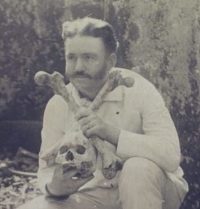Tambobong, Luzon Island –Entry made in parlor of No. 2 Calle Santa Elena, Tondo
Cloudy more or less all day but dry and hot. Tonight my clothes are wet with perspiration. Have returned about one hour since from the village of Tambobong opposite Malibon [Malabon]. Rev. Owens & I started out this afternoon about 2.15 o’clock & walked all the way to this village of nipa huts with the long name. Where is it situated at the Malibon [Malabon] end of the long causeway between Caloocan & Malibon [Malabon], Large, square, fish ponds stretch away north & south on either side of the causeway. A salt water inlet or estuary separates the village from Malibon. We could not enter the latter town because the middle arch of the bridge spanning this piece of water had been blown up by the Filipinos. A large part of the two towns was burnt by the retreating enemy who slipped quietly out. The ruins were still smoking when we arrived. Stragglers from the U.S. army Passed out Call Lemery thro’ the burnt part of Tondo district, made famous by the battle of the 22d & 23rd. Everything is very quiet & about deserted. Several companies of the 4th U.S. Inf. regulars were just getting into quarters at various points along the road to the Malibon causeway, at the American trenches now abandoned. I hardly recognize Caloocan, so completely has it been razed to the ground. A sentinel stopped us as we turned on the causeway. He called the corporal. The latter said we must see his captain. The latter (Captain Andrews of L. Company) demaned our passes somewhat brusquely. We exhibited them. Andrews cautioned us about entering Malibon; said he had no troops in that place & if we went we must take the responsibility on ourselves. We concluded to do that & passed on down the road. About 300 yards from our trenches came to high trenches made of mud in a fish pond on the right hand side of the road going towards Malibon. A low hillock of gravel was thrown across the road. Behind this Filipinos lay to shoot, judging from many empty shells. Men were hurt here. Stains of dry blood were seen, where it had stood in pools, & trails of blood could be traced along the road towards town, made by wounded men. Deep ditches & wide were cut across the causeway in 2 places. We crossed them but were stopped by the broken arch. Examined Tambobong. the large Spanish hospital is a ruin. We saw smoking ruins here & there in Malibon. Towards the north a few miles a great cloud of smoke rose heavenward. Someone ventured the suggestion that Polo was on fire. Was probably another village. We saw not a single Filipino in Tambobong. The sun was getting low & we retraced our steps. Capt. Andrews came out of tent & was very pleasant to us. Invited us to come back & hold service with his men. Promised to “round them up” for us. Leaving him we hastened back to the Caloocan road to catch up with a couple of Government teams. Overtook a four-mule outfit. Had 4 u.S. soldiers & teamster; the latter permitted us to climb on & gave us a much appreciated atho’ rough ride back to Manila. Arrived home about 6.30 p.m. when I turned to & cooked supper.
This morning after Bible reading, prayer & breakfast, I went over to the Dagupan R.R. depot Manila at 8.35 to go out to the front. An officious man –don’t know his name– refused to met me go on the 9. o’clock train. Made the excuse that it was a special. I waited 3 hours altogether until 12. for another train then changed my mind & gave up the idea –too late. Our advance guard is getting near Malolos… Rumor says Gen. Montenego was shot & captured.
